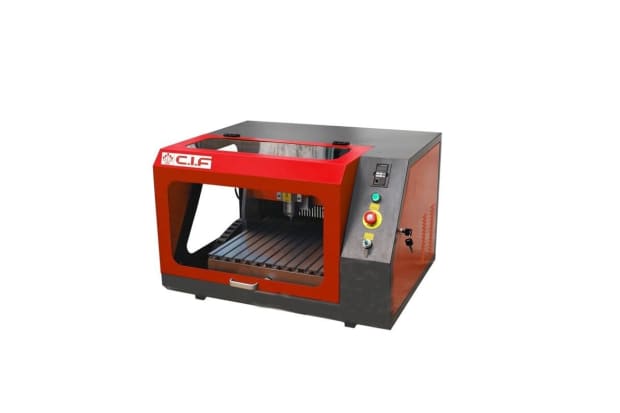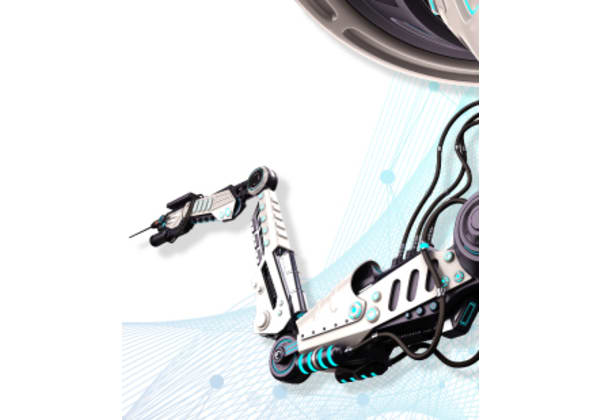- Published 16 Apr 2025
- Last Modified 16 Apr 2025
- 7 min
A Guide to CNC Machining
CNC machining quickly and efficiently creates complex parts in high volumes, making it an essential tool in industry today. Learn here about how these machines work, their main types, and how to care for them.

CNC machining has revolutionised industrial manufacturing by allowing engineers to design and quickly produce complex parts at high precision and volumes. This guide will explain the benefits of CNC machining and outline the types of CNC machines.
What is CNC Machining?
What does CNC stand for? – Computer Numerical Control, which refers to using a computer to create the programmed inputs for a manufacturing machine. It’s long been an enhanced version of numerical control: using punch cards with a numerical system as a rudimentary way to make machine control inputs using an abstracted language. Numerical control was in turn a revolutionary jump from having to program music boxes and cuckoo clocks by manually filing the mechanism’s cams to produce the desired effects.
CNC machining uses these programmed inputs to produce controlled outputs like cutting tool selection, cutting position in a 3D space, feed rate, spin rate, feed depth, and lubricant flow.
How Does CNC Machining Work?
How do CNC machines work? They receive their machining parameters through G-code programming. An engineer takes a designed part (usually prepared with Computer-Aided Design: CAD) and creates G-code for how to make it, often using Computer-Aided Manufacturing (CAM).
CAM gives a user-friendly interface for visualising the machining. This lets the user spot design flaws that could result in poor machining, excessive scrap, or inefficiencies. With CAM, you can realise the full benefits of CNC.
What is Subtractive Manufacturing?
You’ve likely heard of 3D printing. It’s revolutionary since it uses additive manufacturing: progressively adding material to build something. CNC machining, however, uses the more conventional subtractive manufacturing: sculpting by progressively removing bits from a block of material.
What are the differences in additive vs subtractive manufacturing? Subtractive manufacturing:
- Is better for mass production, while additive is good for prototypes
- Achieves tighter tolerances
- Is better suited for making metal parts
- Is limited in part complexity, while additive is nearly infinite
- Requires significant setup
- Produces smoother finishes
- Makes stronger parts
- Uses higher-cost machines
To be clear, though, 3D printers use CNC too (and are of course machines). The word ‘machining’ refers to subtractive manufacturing using high-precision machines. Machining existed long before CNC, which now enhances its capabilities, efficiencies, and output quality.
CNC Machining Uses
Benefits of CNC machining include:
High production speed: CNC machines can select and position cutting tools far faster and with greater precision than humans ever could with manual machining tools.
High efficiency: CNC machining can produce large batches of the same part at high speed, even if parts require multiple different cutting tools to produce. CNC machines can also run nonstop overnight if they’re automatically fed enough raw materials. All this means low production costs with minimal supervision labour.
Reduced errors: CNC essentially removes human error from manufacturing work. These machines produce the desired shapes with extremely high precision and accuracy, letting you assure greater product quality.
Part complexity: With multi-axis machines, part shapes of staggering complexity can be easily produced at reasonable costs, provided the engineer designs the part with practical machining in mind and prepares a working machining program in CAM.
Rapid prototyping: Since these machines allow you to produce complex shapes quickly, you can greatly reduce design iteration time by bringing your design ideas to life, letting your team arrive at the best design sooner.
CNC Applications
What are CNC machines used for? Anything that can be built from CNC machining materials, which include steel, aluminium, copper, wood, and plastic.
Applications for CNC machining include:
Producing parts: CNC’s primary use is to quickly and reliably make machine parts of high complexity.
Mould creation: CNC machining can produce the complex moulds for cast or moulded parts.
Finishing: CNC machining can take over finishing cleanup steps like filing to reduce manual labour.
Automated production lines: CNC machines can be integrated with automated assembly lines to drill and mill certain features once machines reach a certain production stage.
Industries Using CNC
How does a CNC machine work in industrial settings? Here are some products major industries use it for:
- Automotive: Engine blocks, axles, gearboxes, dashboards
- Aerospace: Aerofoils, landing gear, turbine blades
- Electronics: Printed circuit boards, heat sinks, casings, connectors
- Health and dental: Pacemakers, prosthetics, surgical tools, dentures, bridgework
- Energy: Solar panels, valves, bearings, pistons, bushings
All these need high precision at large production volumes, with human safety a large concern, making CNC machining a good choice.
Types of CNC Machines
Here are some of the most prominent different types of CNC machines, though others exist like CNC routers, plasma cutters, and laser cutters.
CNC Lathe
A lathe spins the workpiece while a cutting tool moves in to cut material away. Manual lathes have existed for centuries and are simple to use, but CNC lathes far outperform them in speed and output quality.
Lathes are best suited for round parts in rotational applications, like in driveshafts, for pumps, and turbines.
CNC Mill
CNC mills offer a complete 3D space to work with, making them very versatile. The workpiece stays stationary on a secure bed while the cutting tool moves around it to remove material.
These machines have at least 3 axes, with the cutting tool (oriented either vertically or horizontally by default) having complete freedom of movement in the 3 linear directions. Additional axes add control of the workpiece’s movement.
CNC mills can use drill bits or other cutting tools like reamers or face mills, and they can swap these tools out automatically based on the G-code instructions the engineer feeds it using CAM. CNC mills often encase the workpiece in a sealed compartment, containing material shavings and sprayed lubricants during machining.
These machines offer the greatest versatility in the shapes they can produce and the operations they can perform: drilling, tapping threads, face milling, angular milling, contour milling, and reaming.
CNC EDM
CNC electric discharge machining (EDM) uses electric sparks, rather than physical cutting tools, to cut through material. The workpiece serves as one electrode in this reaction, and is placed next to the machine’s electrode, which acts as the cutting tool. The machine submerges the electrodes in a dielectric fluid and then creates controlled electrical discharges between them to produce a series of destructive sparks that burn away at the workpiece material in a controlled manner.
With EDM, the workpiece must be conductive, so wood and plastics are out of the question. EDM is well suited for harder materials that can be challenging to mill, such as titanium or hardened steel. EDM can produce complex, highly accurate surfaces with minimal residual surface stresses on the material. The dielectric fluid, which is circulated and filtered, also gives advantages for system cooling and washing away the metal shavings.
How Many Axes Do I Need?
We’ve mentioned the axis-count in CNC machines, but what’s meant by that? An axis in a CNC machine is an ability for the cutting tool or the workpiece to change its position by moving along a straight line or rotating in some direction. CNC mills or EDMs typically start with 3 axes, since they can control the height, width, and depth position of the cutting tool or electrode. A lathe usually starts with 2 axes, since the cutting tool just moves along the spinning workpiece’s length and radially from its centre axis to its outer diameter.
When a CNC mill gains axes for its workpiece, such as with a 5-axis machine, the workpiece bed can spin on a turntable which in turn can rock back and forth on an axle. The workpiece and the cutting tool then do a highly synchronised ‘dance’ to allow the tool to reach interior areas of the workpiece and achieve even more complex shapes.
CNC machines can have even more axes than that: each one giving more movement abilities and even having multiple cutting tools at once — and driving up machine costs. Engineers and businesses need to consider what the best CNC machines are for their work based on the up-front costs and the complexity of the parts they need to deliver.
CNC Machine Maintenance
The very best CNC machines, though, are the ones that are well taken care of. Once companies invest in them, they become more reliant on them for their products’ quality and output. If the machine performs poorly or fails, this significantly affects the bottom line. Proactive maintenance is thus essential for these machines’ many moving parts and tight tolerances.
CNC machine maintenance involves:
- Changing cutting tool heads when necessary
- Cleaning parts using a wire brush
- Lubricating moving parts
- Cleaning and refilling coolant, hydraulic, and pneumatic systems
- Diagnosing and resolving excessive vibration
- Monitoring system temperature and cleaning cooling fans and radiators
- Calibration
So even though CNC machines can work nonstop, they need regular maintenance shutdowns to avoid the cost overruns of breakdowns. Train workers on this, keep maintenance records, and have spare parts readily available.
RS can equip you with all the cleaning equipment you need for making sure your CNC machines stay sharp. Browse our selection today.



